Exclusive Interview
Smoke Screen: How one ambitious company is advancing anti-pollution efficacy testing for skin care

CIDP, a global company with headquarters in Mauritius and operations in Brazil, Singapore, India, and Romania, sees a “big customer demand for anti-pollution efficacy testing,” Veronique Newton, the company’s R&D laboratory manager, tells Cosmetics Design.
The demand is coming mostly from skin care manufacturers and from brands in the US and Europe, Newton says. But, there is also demand from CIDP customers in Singapore, India, and Australia too.
CIDP is also getting inquiries about blue-light product testing, but for now those are less common, according to Newton.
Skin care
Anti-pollution skin care tends to provide one of three benefits: barrier protection, cleansing, and damage repair. CIDP has configured testing protocols for all three, but many of the early requests have been for barrier testing.
Finished goods makers are first keen to know if their already-formulated products could also function as anti-pollution skin care, protecting against ambient airborne pollutants, explains Newton.
Still, CIDP offers several, customized tests to assess the anti-pollution benefits of skin care and cosmetic products. Both treated and placebo or control-treated skin can be tested against ozone, cigarette smoke, ambient dust, blue light, sun light, or any combination there of. The company generally recommends a series of tests, starting with in-vitro, and progressing to ex-vivo, in-vivo in the lab, and finally to in-vivo in real conditions, as Newton tells Cosmetics Design.
A similar series of tests is suggested for products that are meant to deliver anti-pollution skin cleaning benefits as well as pollution repair benefits. Newton says that most of the skin cleaning products she and her team test are devices or scrubs. And, she tells Cosmetics Design that while barrier protection testing has been in high demand, the conversations she and her colleagues had at in-cosmetics North America this month suggest that skin cleaning products will be the next wave in anti-pollution.
Hair care
Hair is, of course, exposed to pollutants too. Newton tells Cosmetics Design that she and her team at CIPD are currently doing preliminary work to establish protocols for testing the purported benefits of anti-pollution hair care products.
Newton notes that because the CIDP laboratory testing team can apply their learnings from having developed anti-pollution testing for skin care products to future protocols, she expects anti-pollution hair care tests to be ready for manufacturers quite soon, by the end of the year in fact.
Blue light and beyond
Light is a matter of wavelength. And a as pollutant, it’s “a question of dose…the amount your exposed to,” as Newton points out.
Blue light with a wavelength of 412nm is known to be the most visibly harmful, that is, “is has the most damaging effect on pigmentation,” according to the CIDP team. Other wavelengths however “induce a lot of free radical activity.” So the company is testing three distinct wavelengths.
Products that protect against infrared light are coming, believes Newton. And CIDP already has plans to develop the testing protocols that will help gauge the efficacy of infrared protection and repair products.
And while she’s not convinced that products which will effectively protect the skin against the combined effects of air-borne pollution and blue light are coming anytime soon, Newton sets this sort of skin care as a prime example of the anti-pollution products that formulators and brands should be aspiring to develop.
















